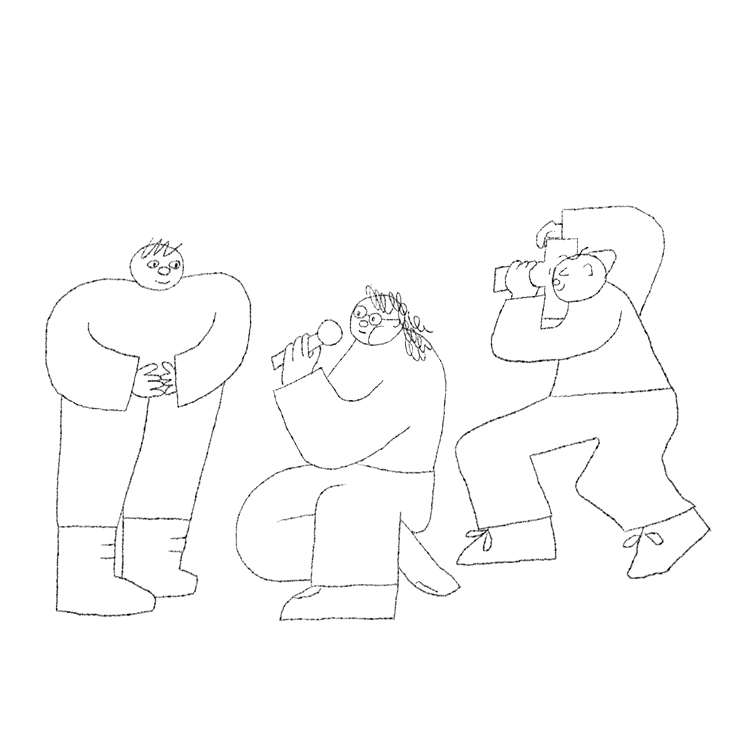大学の中と外で、いまおきているあれこれを紹介する「上智のいまを発見」。
学内のサステナビリティ課題の解決に日頃から取り組んでいるUniversity Innovation Fellows Sophiaが寄稿してくれました。今回は、オランダのサステナビリティツアーと米国スタンフォード大学とトゥウェンテ大学共同主催のミートアップに参加したレポートの前編をお届けします!
Find Sophia Now introduces a variety of things that happen on and off campus.
University Innovation Fellows Sophia, who has been actively working on solving sustainability issues within our campus, has kindly contributed this article. We present the first part of their report on the UIF Dutch Sustainability Tour and the meetup co-organized by University of Twente and Stanford University.
2024年4月12日から14日にかけて、上智大学のUniversity Innovation Fellowsの一団が、オランダのトゥウェンテ大学デザインラボで開催された2024年Global UIF Meetupに参加しました。エンスヘデでの3日間のミートアップに先立ち、フェローたちは自ら企画した1週間のスタディーツアーでアムステルダムを訪問しました。オランダのイノベーション、サステナビリティ、循環型経済、そして社会的インパクトに触れる機会を持ちました。
From April 12-14, 2024, a group of University Innovation Fellows (UIF) from Sophia University and Tohoku University participated in the 2024 Global UIF Meetup held at the University of Twente’s Design Lab in the Netherlands. Prior to the 3-day Meetup in Enschede, the fellows participated in a self-organized week-long study tour in Amsterdam to immerse themselves in the Dutch culture of innovation, sustainability, circularity, and social impact.
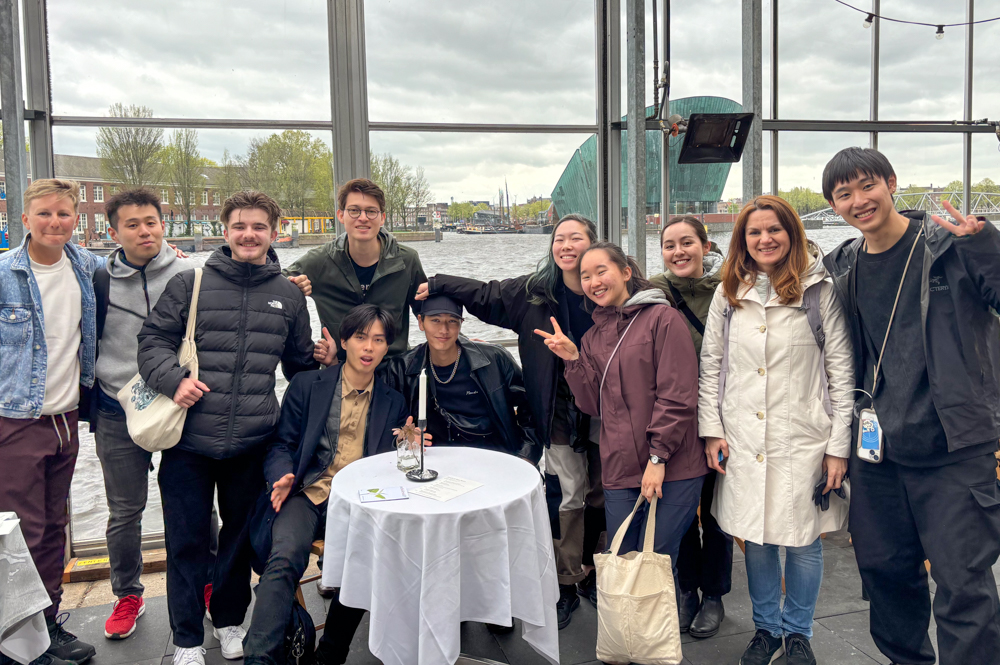
アムステルダムは、世界で最も環境に配慮し、持続可能な都市づくりに励んでいる都市として知られています。2020年には、都市の循環型経済戦略が発表され、2050年までに完全な循環型経済を達成するという野心的な目標が掲げられました。この取り組みでは、ドーナツ経済モデルも導入され、社会的公正と生態学的持続可能性のバランスを取る新しい経済のアプローチが提唱されています。しかし、この野心的なビジョンは実際にはどのように機能しているのでしょうか?様々な関係者は、循環型経済への移行をどのように推進し、構築しているのでしょうか?
これらの疑問を探求するために、上智大学と東北大学の学生グループは、スタンフォードd.schoolが提供するUIFプログラムに参加し、アムステルダムで5日間、様々な組織、大学、文化的施設を訪問しました。このスタディーツアーは上智大学のフェローが企画したもので、オランダ文化を学び、様々な分野で社会的・生態的課題に対処するための解決策がどのように設計されているかを実地で学ぶための体験型学習として有意義なものとなりました。
Amsterdam is recognized today as one of the greenest and most sustainable cities in the world. In 2020, the city unveiled its Circular Economy Strategy, with an ambitious goal of achieving full circularity by 2050. This initiative also introduced the Doughnut Economics Model – a new approach to fostering a thriving economy that balances social equity with ecological sustainability. But what does this ambitious vision look like in practice? How are various stakeholders driving this transition towards a circular economy and designing alternative ways of living, being, and doing?
To explore these questions, a group of Sophia and Tohoku University students in the UIF program offered by the Stanford d.school spent five days in Amsterdam visiting various organizations, universities, and cultural sites. The study tour was designed by Sophia fellows as an embodied learning experience for their fellow peers to learn about Dutch culture and see first-hand how people in different fields are designing solutions to pressing social-ecological challenges.
1日目&2日目
Day 1 & 2
初日はアムステルダムでのサステナブルショッピングツアーから始まりました。私たちは、パーソナルケア、スローファッション、ヴィンテージ服、ヴィーガンスナック、ゼロウェイストショッピングを提供するショップを訪れました。サステナビリティガイドのマリェ・ファン・ハーレムさんが、循環型経済とスローファッションの理念をビジネスモデルに取り入れたショップを案内してくれました。
最初の訪問先は、2020年にオープンしたオーガニック石鹸店「ネイチャーバー」。ここではシアバターやヒナギクなど、100%天然成分から作られたバーソープやその他のパーソナルケアアイテムを製造しています。店内に足を踏み入れると、コーヒーの香りのする石鹸バーなど、様々な成分の香りが融合し、芳香に満ちた心地よい空間が広がっていました。マリェさんは、ボトル入りのハンドソープやシャンプーの平均75~80%が水でできていることを説明し、固形ハンドソープやシャンプーに切り替えることで、どれだけの水を節約できるかを想像してみてくださいと問いかけました。日常生活のほんの小さな変化で、それが可能なのです。
続いて訪れたのは「ブランドミッション」というスローファッションストアで、そこでは持続可能なビジネス慣行や有機素材を採用し認定された様々なブランドの衣服を販売していました。店の入り口には「誰が私の服を作ったの?」というサインが掲げられていました。私たちが普段ほとんど考えないような質問ですが、この問いをきっかけに、ファッションショッピングの行動を変えるために調査を行えば、それがファッション企業だけでなく、その背後にいるすべての人々に多大な影響を与えるのではないでしょうか。
次に、循環型経済の理念に基づくイニシアティブを実施している別のファッションストア「ザ・スワップ・ショップ」を訪れました。この店では、顧客が古い衣服を他のヴィンテージ服と無料で交換できる仕組みを提供しています。衣服の交換(別の言い方をすれば、まだ使えるものを再利用すること)は、持続可能性と循環型経済を重視する考え方の優れた例です。続いて訪れたのは、もう一つのファッションストア「レナ・ライブラリー」という、普通の店とは異なるファッション図書館でした。ここは、図書館で本を借りるように、服をレンタルできる場所です。このような店が日本にもあるかを考えていたところ、一度しか着ないリクルートスーツを買う人が多い就職活動シーズンに特に需要がありそうだと思いました。
We started our first day with a sustainable shopping tour in Amsterdam, where we visited shops that cater to personal care, slow fashion, vintage clothes, vegan snacks, and zero-waste shopping. Marije van Haarlem, our sustainable guide, took us to many amazing shops that embodied the notion of circularity and slow fashion in their business models. Our first stop was Nature Bar, an organic soap store opened in 2020 that produces bar soaps and other personal care items made from 100% natural ingredients like shea butter and daisies. When we stepped into the store, the scent of various ingredients – including a coffee-scented soap bar – fused together, creating a fragrant and highly pleasing atmosphere. Marije explained that, on average, 75-80% of bottled hand soaps and shampoos are made of water, so imagine how much water we could save if we switch to solid hand soaps and shampoos! And that is possible by just making a very small change in our daily lives.
Next, we visited Brandmission, a slow fashion store that sells a variety of clothing brands – all certified to have been adopting sustainable practices and organic materials in their manufacturing processes. At the entrance of the store was a sign saying, “Who made my clothes?” This is a question that we barely ask ourselves, but if we ask and do some research to change our fashion shopping behaviors, it could have great positive impacts on not just the clothing companies but also for everyone who works behind the clothes.
After Brandmission, we went to another fashion store implementing initiatives under the circularity notion, The Swap Shop, which allows customers to swap old clothes with other vintage clothes in the store for free. The idea of swapping clothes (which, framed differently, is about reusing what is still usable) is an excellent example of the mindset that values sustainability and circularity. Next, we visited another fashion store, Lena Library, but it was not just a normal store, it was a fashion library! A place where you could rent clothes just like how you can rent books from a library. We were considering whether this kind of store was available in Japan, as this would especially be in demand during the job hunting season when people buy “recruit suits” only to wear once.

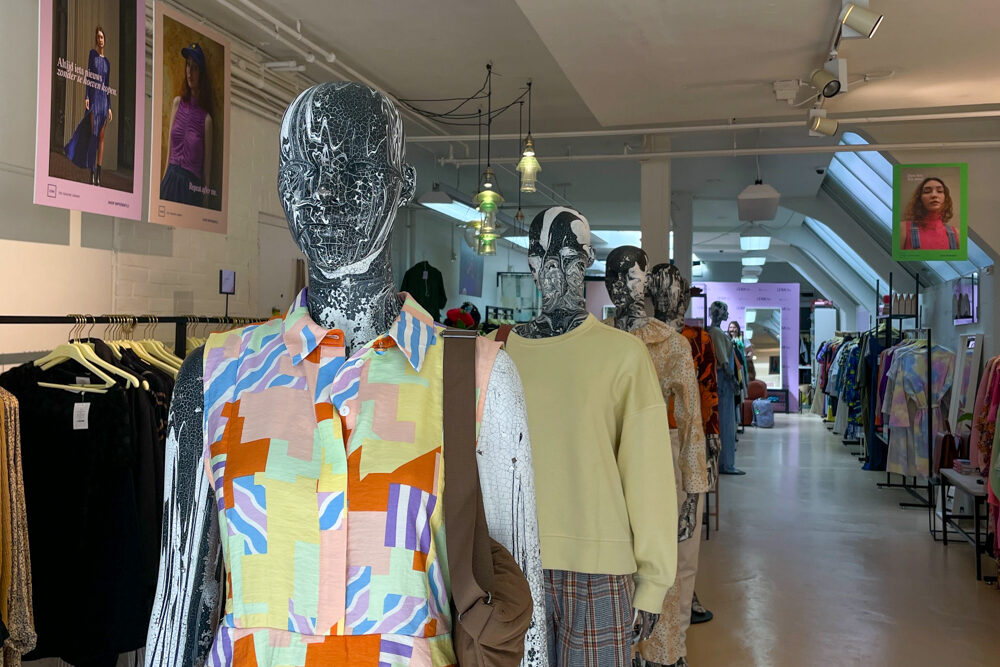
最後の訪問先は、量り売りショップ「デリシャスフード」。顧客は様々な穀物、果物、ナッツなどの乾燥食品を必要な分だけ購入でき、プラスチック包装を減らすのに最適な方法で買い物ができます。このサステナブルツアーは、循環型経済と持続可能性の原則が様々な業界でどのように応用されているかを示す素晴らしい実践的な経験を提供してくれました。将来的には、このような店が世界中に増え、消費者がますます意識的に選択し、その影響を考えるようになることを期待しています。
2日目は、オランダの芸術、建築、都市デザインの文化に浸り、著名な美術館(ライクスミュージアムとモコ美術館)を訪問しました。また、5Dバーチャルフライト体験「This is Holland」やアムステルダムの360°展望台「A’DAM Lookout」などの最新の観光名所も体験しました。さらに、アムステルダムの人々の生活を新たな視点で観察できる運河クルーズにも乗りました。幸運なことに、空は晴れて美しく、歴史的なアムステルダムの街並みを眺めながら運河クルーズを満喫しました
Our last stop was a bulk food shop called Delicious Food, where customers can purchase dry foods such as a variety of grains, fruits, and nuts in exactly the amounts they need – an excellent way to reduce plastic packaging. Overall, this sustainable tour provided us with a wonderful hands-on experience, demonstrating how the principles of circularity and sustainability can be applied across various industries. In the future, we hope to see more of these kinds of stores worldwide and that consumers become increasingly mindful of their choices and impacts.
The second day began with an immersion into the Dutch culture of arts, architecture, and city design, including visits to renowned museums (Rijksmuseum and Moco Museum) and experiences on the latest travel attractions such as 5D virtual flight experience ‘This is Holland’ and 360° observation deck of Amsterdam at A’DAM Lookout. In addition, we cannot forget to mention the beautiful canal cruise which allowed us to have a new perspective in observing the lives of people in Amsterdam. The weather was sunny and beautiful, and we enjoyed our canal cruise while seeing the historic streets of Amsterdam.
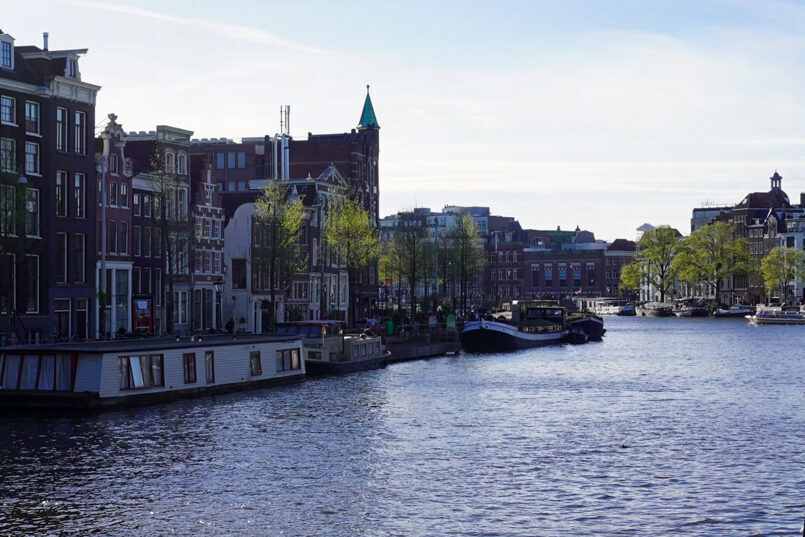
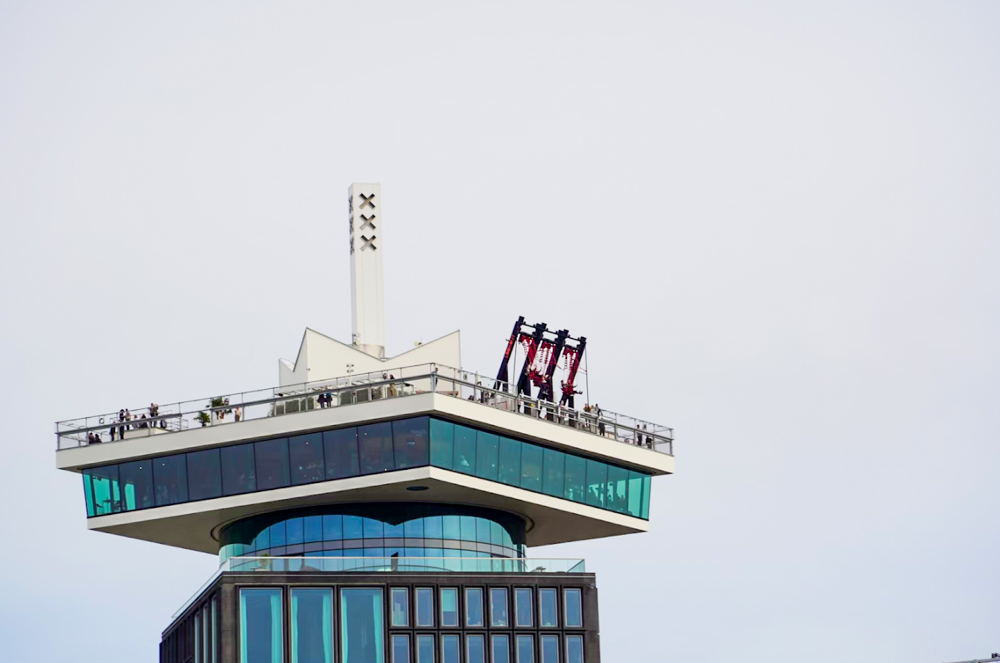
3日目
Day 3
3日目は、アムステルダムサイエンスパーク内にあるパーマカルチャーガーデン兼フードフォレスト「Anna’s Tuin & Ruigte(ATR)」の訪問から始まりました。2017年にオープンしたこの1ヘクタールの緑地は、自然の生態系を模倣し、人間と自然の共存を促進する再生可能な空間を創出するために構築されました。ATRは約40人のボランティアによって運営され、地域住民が自然と再びつながり、持続可能な都市農業やアグロフォレストリーの実践を学ぶための穏やかな空間を提供しています。
地域住民と緊密に協力し、コミュニティコンポストなどの取り組みを行う一方、アムステルダム大学(UvA)などの学術機関と連携して、研究や教育を推進しています。ATRのコーディネーターであるエスター・クロップさんの案内で、庭園とフードフォレストを見学しながら、ワイルドガーリックやシチュアンペッパーなど様々な植物を味わいました。このコミュニティが、都市環境の中で生物多様性を育み、人々と自然を再び結びつけている様子を見るのは、とても感動的でした。
We kicked off our third day with a visit to Anna’s Tuin & Ruigte (ATR), a permaculture garden and food forest nestled within Amsterdam Science Park. Opened in 2017, the 1-hectare green space was built around a holistic design approach that mimics natural ecosystems and seeks to create regenerative spaces that promote human-nature coexistence. ATR is run by around 40 volunteers and open to visitors year-round, offering local residents a peaceful space to explore, reconnect with nature, and learn about sustainable urban farming and agroforestry practices. In addition to working closely with local residents through initiatives such as community composting, ATR collaborates with academic institutions like the University of Amsterdam (UvA) to promote research and education. We enjoyed a tour of the garden and food forest with Esther Krop, the coordinator of ATR. As we walked through the different permaculture zones, we got to taste a variety of plants, from wild garlic to Sichuan pepper. It was inspiring to see how the ATR community is fostering biodiversity and reconnecting people with nature in an urban context.
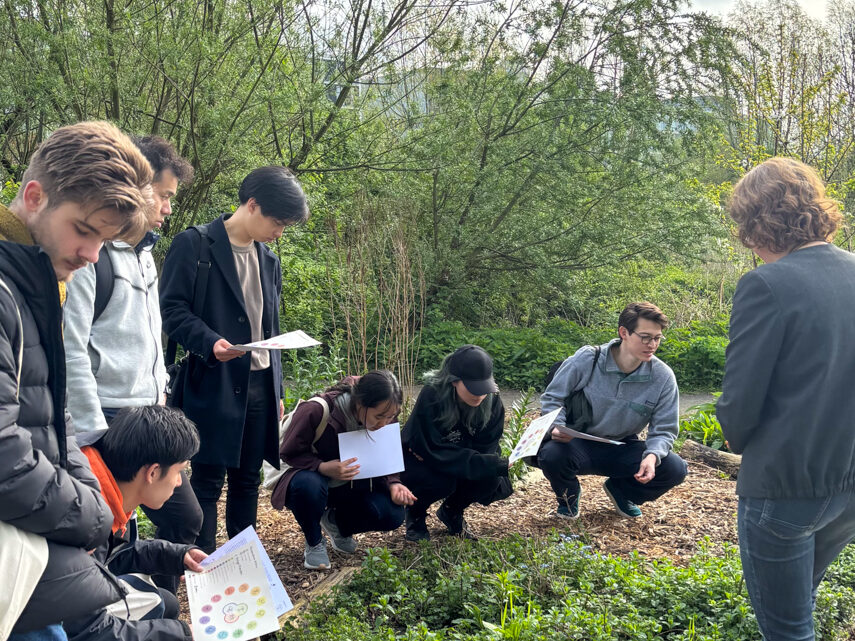
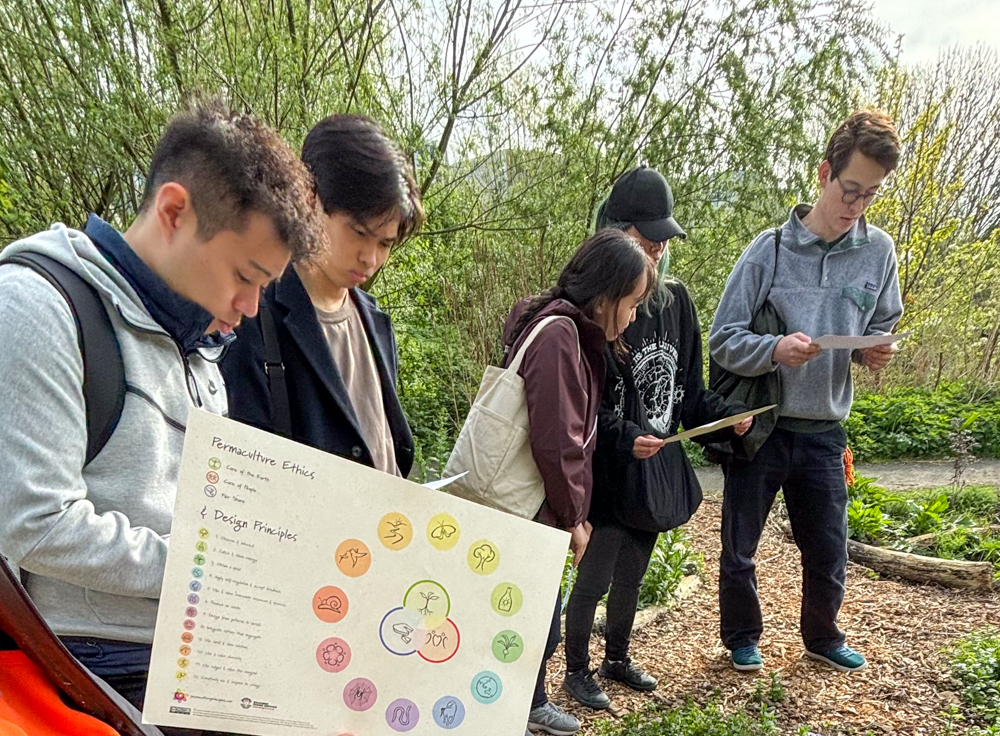
昼食は、アムステルダムの最もスマートな建物の一つであり、持続可能なイノベーションの拠点でもあるMatrix ONE内のベジタリアンカフェで食べました。その後、アムステルダム大学(UvA)のグリーンオフィスのメンバーと会いました。「グリーンオフィスモデル」は、オランダの高等教育機関で人気となり、その後ヨーロッパ各地に広がった持続可能性ガバナンスのユニークなアプローチです。グリーンオフィスは、学生が大学の管理部門と密接に連携し、社会的および環境的持続可能性に取り組むための持続可能性ハブおよび部門として機能しています。2016年に設立されたUvAグリーンオフィスは、大学キャンパスをよりグリーンにするために学生が先導している素晴らしい例です。
私たちは、共同マネージャーのアンカ・スシツカーさんとミカエラ・ラモスさん、そして組織の多くのチームリーダーやメンバーから温かく迎えられました。キャンパスツアーを通じて「バイクキッチン」と呼ばれる自転車修理ワークショップや、サステイナブルカフェテリア(ヴィーガンフードの選択肢を増やし、リユーザブルカップ、プレート、カトラリーへの大学全体の移行を推進するサステイナブルな食堂)プロジェクトなど、様々な取り組みを紹介してくれました。私たちは学生との交流を楽しみ、UvAグリーンオフィスのメンバーが大学内の多様なステークホルダーと協力し、より持続可能なキャンパスを共に創り上げている様子を見ることができ、良い学びになりました。
After eating lunch at a vegetarian cafe inside Matrix ONE, one of Amsterdam’s smartest buildings and a sustainable innovation hub, we made our way to the UvA Green Office. The Green Office model is a unique approach to sustainability governance that became popular in higher education institutions in the Netherlands and has since spread throughout other parts of Europe. Green Offices function as a sort of sustainability hub and department that enables students to work closely with the university administration on social and environmental sustainability efforts. The UvA Green Office, which was established in 2016, is an inspiring example of how university students are leading the way in making their campus more green. We were warmly welcomed by co-managers Anka Sušická and Michaella Ramos, along with a number of team leaders and members of the organization. They first gave us a tour of their campus, introducing us to exciting initiatives like the Bike Kitchen, a bicycle workshop where you can learn how to repair and maintain your own bike, and their sustainable cafeteria project, where they are striving to increase options for vegan food and pushing for a university-wide transition to reusable cups, plates, and cutlery. We had a great time engaging with the students and felt empowered to see how members of the UvA Green Office are collaborating with a wide range of stakeholders at their university to co-create a more sustainable campus.
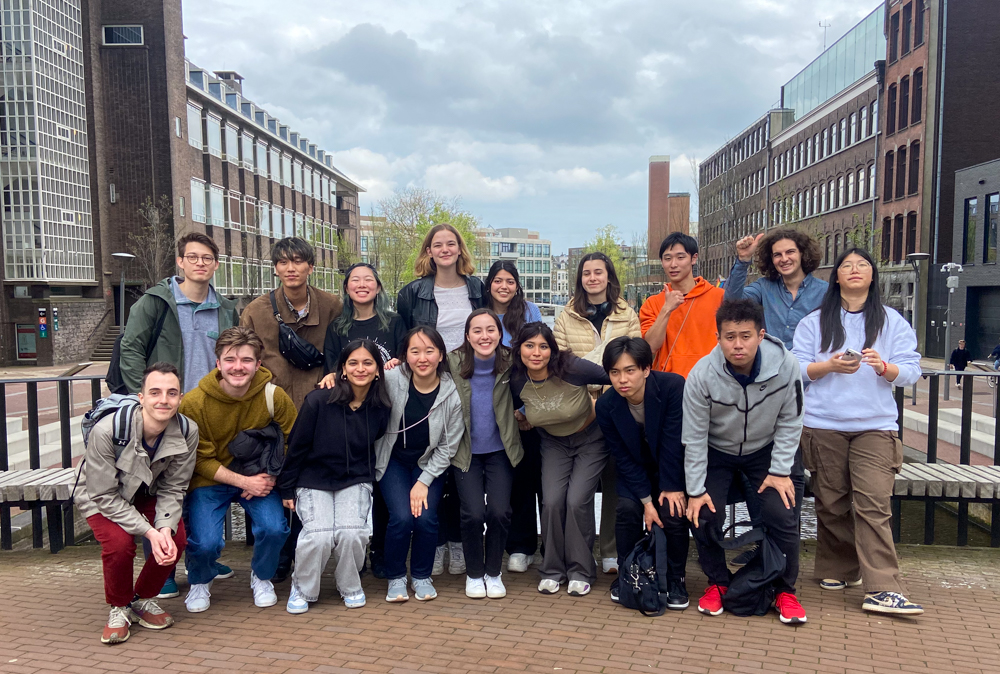
UIF Japan and UvA Green Office members
その日の最後の訪問先として、私たちはアムステルダム自由大学(VU)のアテナ研究所に向かいました。ここでは、「21世紀の経済と社会における技術革新の利点と欠点」というテーマで、VU日本コーディネーターのガガン・カウルさんが企画した共同セッションに参加しました。
理学部化学・薬学科のバート・ボシンク教授は、技術革新の突破口についてのプレゼンテーションを行い、ビジネスや社会における変革の可能性を語ってくれました。VUの研究者が手掛けた革新的なベンチャーを例に挙げ、技術を責任を持って使用し、より多くの人々がアクセスできるようにする重要性を強調しました。
次に、アムステルダムのデザインシンカーズアカデミーのティム・シュールマンさんが、デザイン思考をどのように適用し、チームやプロフェッショナルが企業内外で革新的な変化を促進する方法についての洞察を共有してくれました。最後に、トランスディシプリナリーSTS(科学、技術、社会)の助教であるタカハシマコト氏が、「目に見えないを写す」というテーマで、2011年の福島原発事故を忘れないために彼の学生と共同で企画した巡回展についてプレゼンテーションを行いました。彼は、放射線の影響やそれが人々の生活に及ぼす持続的な影響を捉え、見えないものを見えるようにするアート作品を手掛ける川久保ジョイや志賀理江子などのアーティストの強力な作品を紹介しました。
このセッションは、芸術、技術、デザイン思考を統合して有意義な革新を促進するために、学際的な協力の重要性を示す非常に洞察に富んだ内容でした。
For our last visit of the day, we headed to the Athena Institute at Vrije Universiteit Amsterdam. Here, we participated in a collaborative session on “The Upside and Downside of Technological Innovation for 21st Century Economies & Societies” organized by VU Japan Coordinator Gagan Kaur. Professor Bart Bossink of the Faculty of Science, Chemistry and Pharmaceutical Sciences kicked off the session with a presentation on breakthrough tech innovation, highlighting its transformative potential for both business and society. Drawing examples from the innovative ventures initiated by VU researchers, he underscored the importance of using technology responsibly and ensuring greater accessibility. Following this was a presentation by Tim Schuurman from the DesignThinkers Academy in Amsterdam, who shared insights into the ways in which design thinking can be applied to empower teams and professionals to drive innovative change in their companies and beyond. Finally, Dr. Makoto Takahashi, Assistant Professor for Transdisciplinary STS (Science, Technology, & Society) delivered a presentation on “Picturing the Invisible,” a traveling exhibition he curated in collaboration with his students in memory of the 2011 Fukushima nuclear disaster. He shared powerful works by artists such as Yoi Kawakubo and Lieko Shiga, who make the invisible visible through their pieces by capturing the effects of radiation and its lingering impacts on people’s lives. It was a deeply insightful session that showed us the importance of transdisciplinary collaboration and integrating art, technology, and design thinking to drive meaningful innovation.
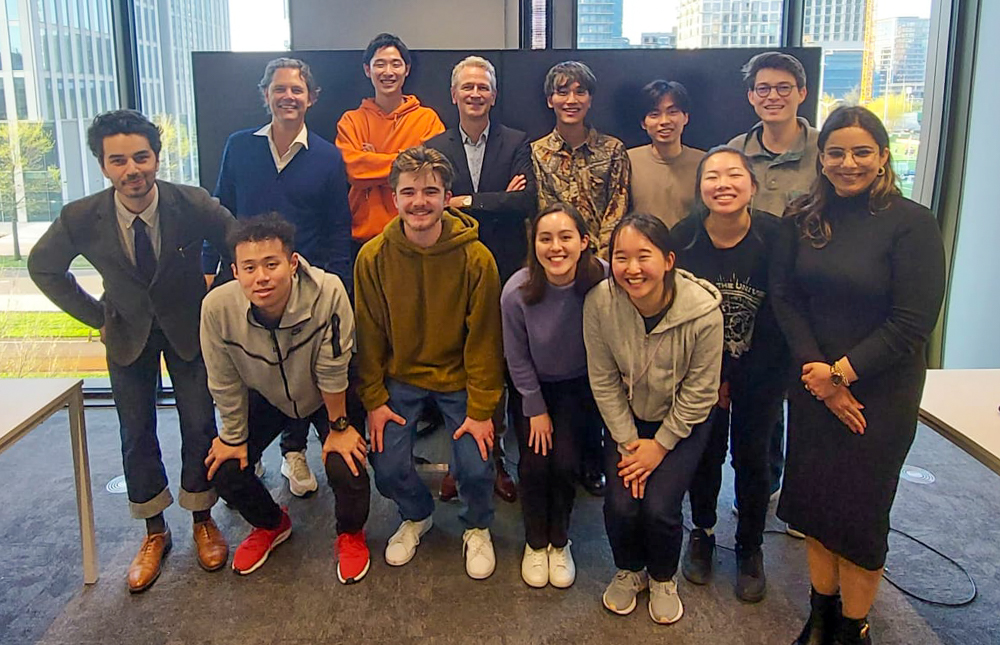
Inside Athena Institute at Vrije Universiteit Amsterdam
4日目
Day 4
4日目には、Kennislandのディレクターであり、元アムステルダム副市長のマリエケ・ヴァン・ドーニンクさんとの会合がもたれ、マリエケさんが主導したプロジェクトやイニシアティブについて、地域レベルから国際レベルまで幅広く学びました。特に、彼女が副市長を務めていた際に、アムステルダム市にドーナツ経済モデルを導入し、社会的に公正で環境的に持続可能な都市を創造するための新しいアプローチを提案したことに注目しました。
現在、社会イノベーションを促進する先駆的なシンクタンクであるKennislandでは、教育、政策立案、市民参加、持続可能な発展に焦点を当てたプロジェクトに取り組んでおり、政府機関、企業、地域社会と協力して、差し迫った社会的課題に対する解決策を共創しています。これらのプロジェクトには、若者の教育機会の拡充、医療制度の改善や高齢者支援ネットワークの強化、より民主的で持続可能な社会への移行を目指す政府のサポートが含まれます。
マリエケさんの活動家としてのストーリーを聞きながら私たちは感動し、励まされました。それは、社会イノベーションが実際に行われている力強い例であり、コミュニティ主導の解決策がより公正で持続可能な世界を構築するための変革の可能性を示していました。
On our fourth day, we had the honor of meeting with Marieke van Doorninck, the director of Kennisland and the former Deputy Mayor of Amsterdam. We learned about the wide range of projects and initiatives that Marieke has headed, from the local to international level. Most notably, Marieke introduced the Doughnut Economics model to the city of Amsterdam during her time as Deputy Mayor, presenting a new approach to creating a more socially just and environmentally sustainable city. Now at Kennisland, a pioneering think tank dedicated to fostering social innovation, Marieke is working on projects focused on education, policy-making, civic engagement, and sustainable development, working collaboratively with government bodies, companies, and local communities to co-create solutions for pressing social challenges. Some of the projects include enhancing educational opportunities for youth, improving the healthcare system and elderly support networks, and supporting the government in transitioning towards a more democratic and sustainable society. Hearing Marieke’s story of activism left us both inspired and empowered, as it offered a powerful example of social innovation in action and showed us the transformative potential of community-driven solutions for building a fairer, more sustainable world.
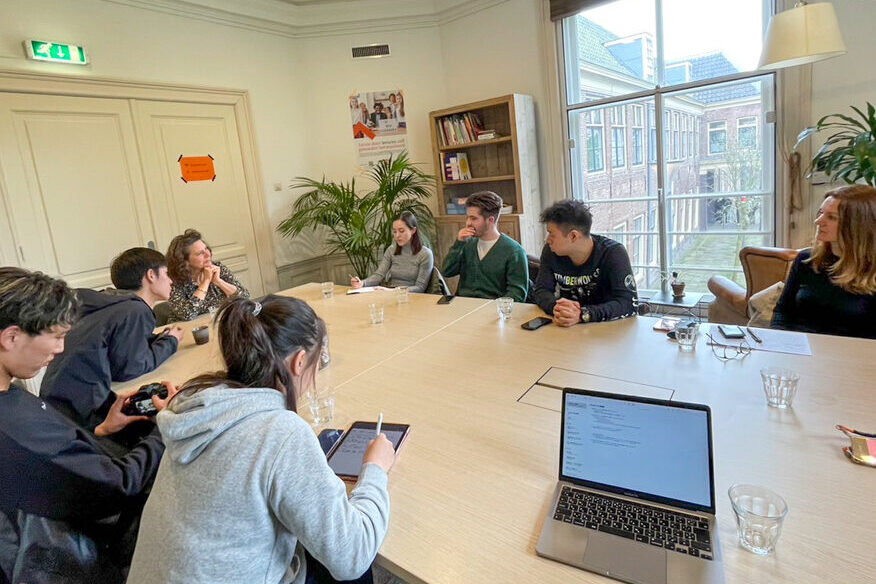
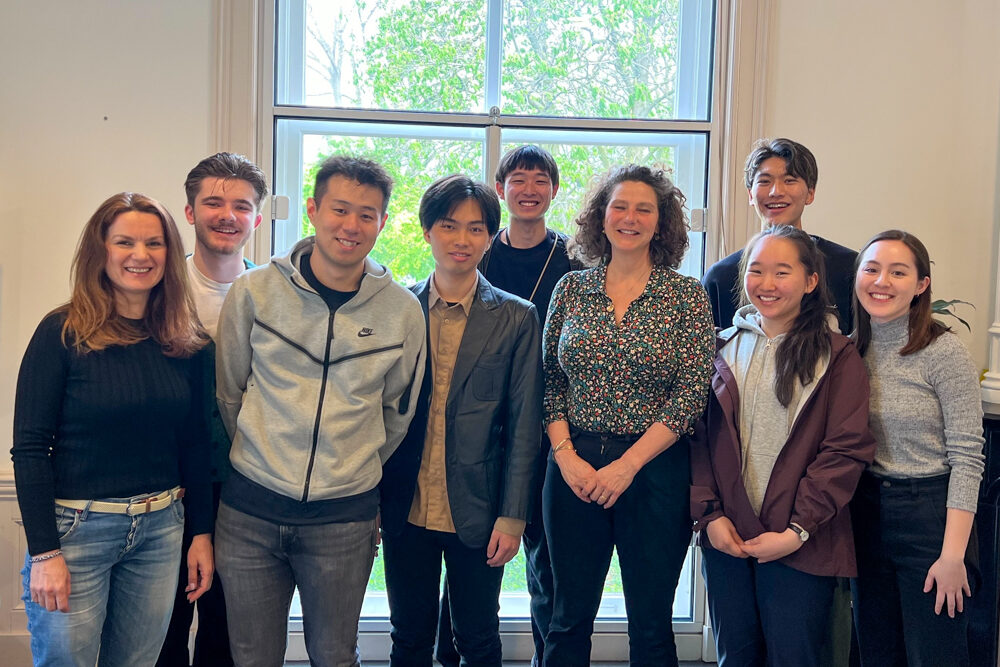
次にMediamaticに行きました。ここは、アート、生物学、食、香りが交差する拠点であり、これらの分野の融合を体験し、自然に関連する目を見張るような展示やアート作品を鑑賞する機会を得ました。Mediamaticは、アムステルダムのマリネテレイン地域にある機関で広く採用されている「リビングラボ(生きた実験室)」の概念を体現する場でした。実際、マリネテレイン地域全体が、科学者や政策立案者が革新的なアイデアを実験するためのリビングラボとして機能しています。
Mediamaticでは、フレッシュハーブや植物でいっぱいのアクアポニック温室、菌糸でできた鳩の塔、ヨーロッパ最大の香りのラボ(様々な香りが並んだ壁板があります)、植物ベースのレストラン、日本の外来植物であるイタドリに捧げられたアート作品、そして庭の植物に水を与えるために尿を循環させる公共のトイレなどを目にしました。これらのプロジェクトや展示は、循環性、持続可能性、そして科学を中心としたアート、生物学、食、香りの異なる組み合わせを示しており、とても興味深いものでした。
Then we headed to Mediamatic – a hub for art, biology, food, and aroma, where we had the chance to immerse ourselves in the intersections of these areas and experience eye-opening exhibitions and artworks related to nature. Mediamatic was truly a living laboratory – a concept widely embraced by institutions in the Marineterrein area of Amsterdam. In fact, the entire Marineterrein area serves as a living laboratory where scientists and policymakers gather to experiment with innovative ideas. At Mediamatic, we saw an aquaponic greenhouse full of fresh herbs and plants, pigeon towers made of mycelium, Europe’s largest open aroma lab with a wallboard full of different scents, a plant-based restaurant, an artwork dedicated to Japanese knotweed, and a public urinal that recirculates urine to water the garden plants. The projects and exhibitions were fascinating, showcasing different combinations of art, biology, food, and aroma centered around the core values of circularity, sustainability, and science.
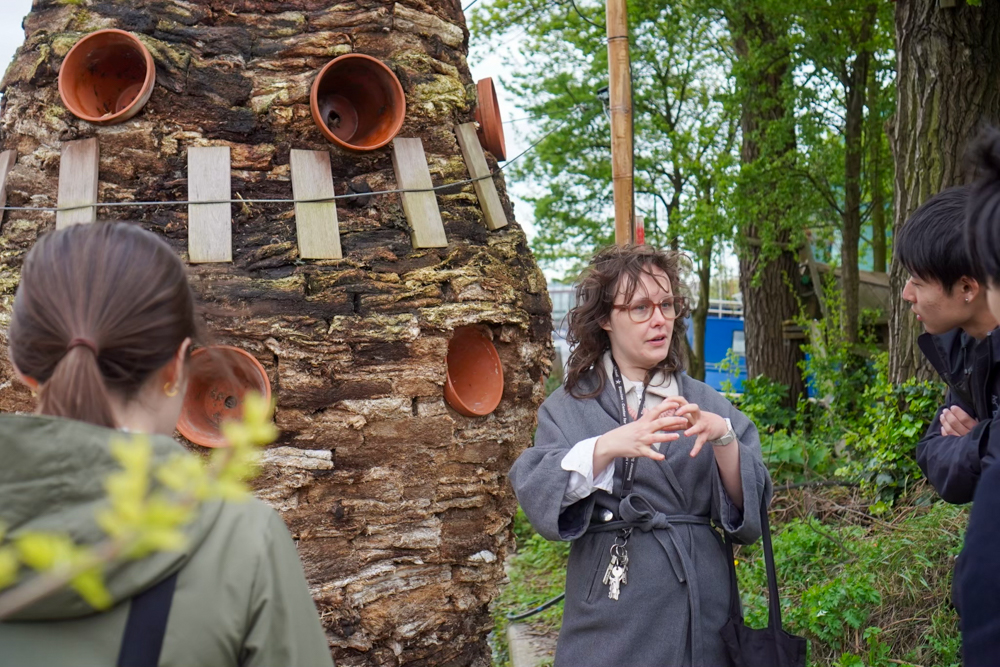
Pigeon tower outside Mediamatic’s facility

午後は、デザインシンカーズアカデミー(DTA)を訪問しました。DTAはアムステルダム発祥のデザイン機関で、現在では25か国以上で活動しており、チームの創造性やイノベーションを高めるためのコースやプロジェクトサービスを提供しています。DTAのティムさんとクリスティーナさんからは、機関やプロジェクトについて、またクライアントが顧客に最も的確な価値を提供するためにどのようにサポートしているかについて話を伺いました。
デザイン思考を学び始めたばかりの私たちにとって、DTAの人々が組織が最良の製品を作り、最も価値のあるサービスを提供するために、実践的なデザイン思考アプローチを先導している様子を見ることは非常に刺激的でした。デザイン思考は、マネージャーやデザイナーがユーザーを理解し、仮定に挑戦し、革新的な解決策を生み出すために使用する人間中心の問題解決アプローチです。これには、共感、定義、発想、プロトタイプ、テストの5つの主要なフェーズが含まれます。
In the afternoon, we visited the DesignThinkers Academy (DTA). Originating in Amsterdam, DTA is now a multinational design institution operating across 25 countries and offering courses and project services to help teams develop creativity and innovation. Tim and Christina from DTA shared about their institution and projects, as well as about how they help their clients provide the most precise value to their customers. As fellow – but beginner – design thinkers, it was inspiring for us to see how people at DTA were pioneering the practical approaches of design thinking by helping organizations build the best products and create the most valuable services for their customers. For those unfamiliar with design thinking, it is a human-centered problem solving approach used to understand users, challenge assumptions, and create innovative solutions. It encompasses five key phases: Empathize, Define, Ideate, Prototype, and Test.
5日目
Day 5
ツアー最終日には、アムステルダム先進都市ソリューション研究所(AMS Institute)を訪問しました。ここは、マサチューセッツ工科大学(MIT)、ワーゲニンゲン大学、デルフト工科大学、そしてアムステルダム市との共同の公私協力研究機関です。AMSのリビングラボコーディネーターであるジーナ・ゴマーさんと協力し、AMSの学生や研究者を対象にした共創ワークショップを開催しました。このセッションを通じて、ステークホルダーの理解、コミュニティメンバーの関与、そして最良の成果を得るための共創の重要性と価値を学びました。
セッション終了後、ジーナさんはAMSで実験中の最先端技術やサービスをいくつか紹介してくれました。その中には、自動運転ボートプロジェクト「Roboat」や、電動自転車の充電スタンド、3Dプリンティングで作られた持続可能な住宅など、都市課題に対する革新的な解決策が含まれていました。若い科学者や研究者たちが都市の課題に様々な分野から取り組み、創造的なアイデアやプロトタイプを生み出している姿を目の当たりにし、私たちは感動しました。
On the last day of our tour, we visited the Amsterdam Institute for Advanced Metropolitan Solutions – a public-private research institution involving the collaboration among the Massachusetts Institute of Technology, Wageningen University & Research, Delft University of Technology, and the city of Amsterdam. We collaborated with Gina Gommer, the living lab coordinator, in organizing a co-creation workshop for the students and researchers at AMS. Bre Przestrzelski and Tomo Loeer, fellows from the UIF program, first-handedly designed and facilitated the workshop, which taught us the importance and value of understanding stakeholders, engaging community members, and co-creating solutions to achieve the best outcome for everyone. After the session, Gina showed us some of the cutting-edge technologies and services they have been experimenting with, including the autonomous boat project Roboat, an e-bike charging stand, a sustainable house created by 3D printing, and many more innovative solutions for urban challenges. It was inspiring for us to witness the creative ideas and prototypes that were created by young scientists and researchers at AMS, all trying to address the challenges of the city from various fields and disciplines.
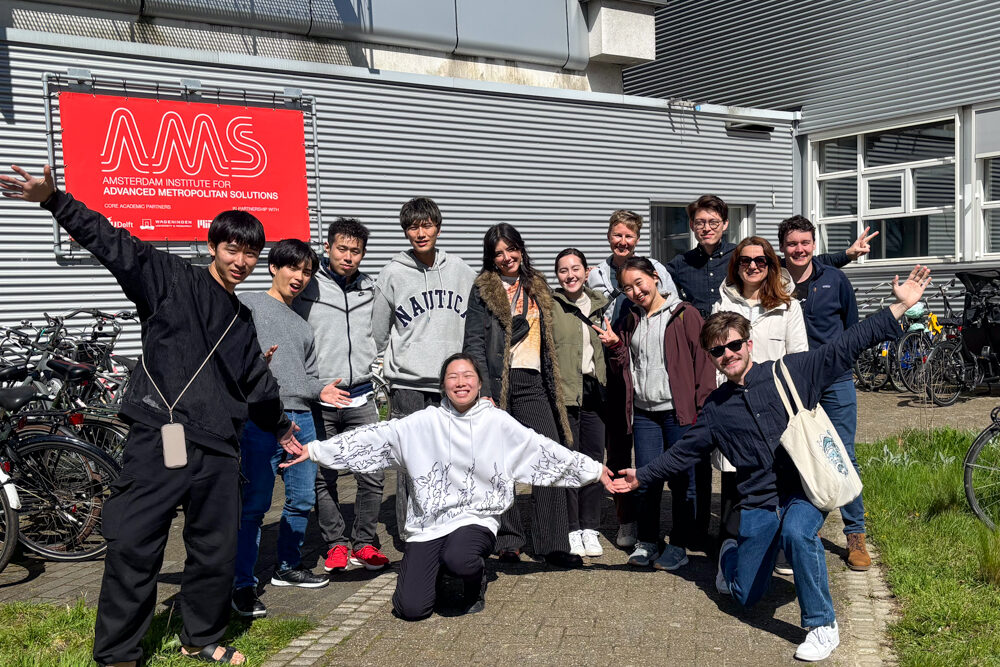
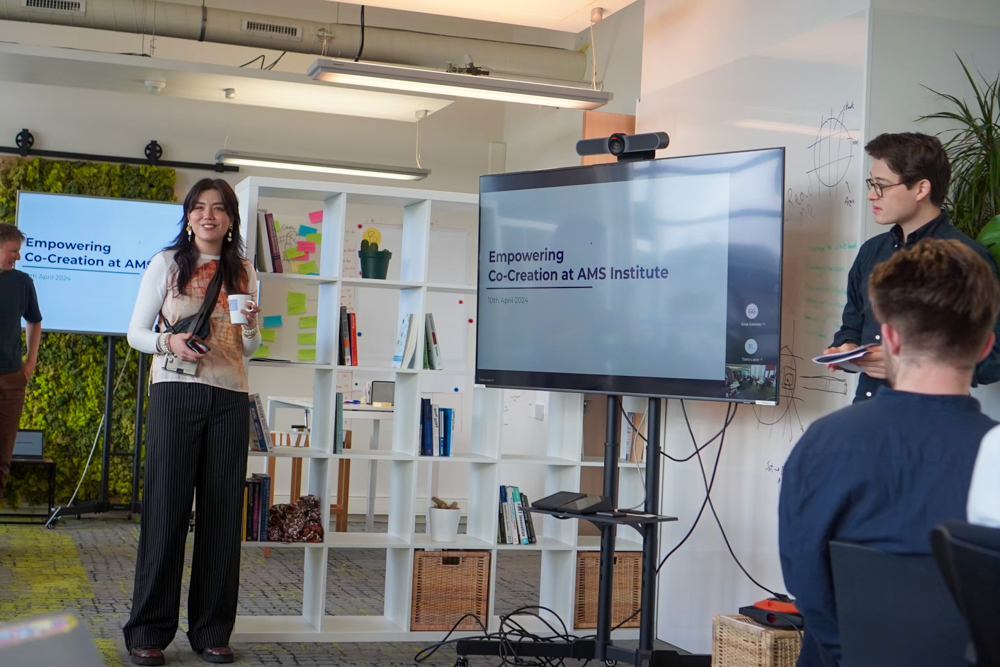
次にアムステルダムに拠点を置く印刷会社ロブストルクを訪れ、色と素材が交錯する世界を体験し、印刷プレスを支えるクラフトとテクノロジーの驚くべき融合を目撃しました。クリエイティブディレクターのフリークさんに案内され、素晴らしい印刷物を作り出す道具や機械を見学するとともに、印刷プロセスにおいて色や素材に注がれる注意と努力についても理解を深めました。
デジタル化の時代において、印刷物の価値を見過ごすことは容易です。しかし、各印刷物に込められた献身と芸術性を目の当たりにした私たちは、様々な紙や色が私たちの思いや意図を観客に伝える上でどれほど重要な役割を果たしているかを実感しました。質感からトーンに至るまで、すべての要素が、印刷を通じて伝えるメッセージの形を作る上で重要な役割を果たしているのです。
Next, at Robstolk, a printing company based in Amsterdam, we delved deep into the realm where colors and materials intertwine, and witnessed the remarkable fusion of craft and technology that powers a printing press. Guided by Freek, the company’s creative director, we were not only given a tour of the tools and machines that create stunning prints but also gained insight into the attention and efforts devoted to colors and materials in the printing process. In the age of digitalism, it is easy to overlook the value of printed materials. Yet, after observing the dedication and artistry behind each print, we came to appreciate the intricate impact that various papers and colors have on conveying our thoughts and intentions to an audience. From texture to tone, every element plays an important role in shaping the message we communicate through print.
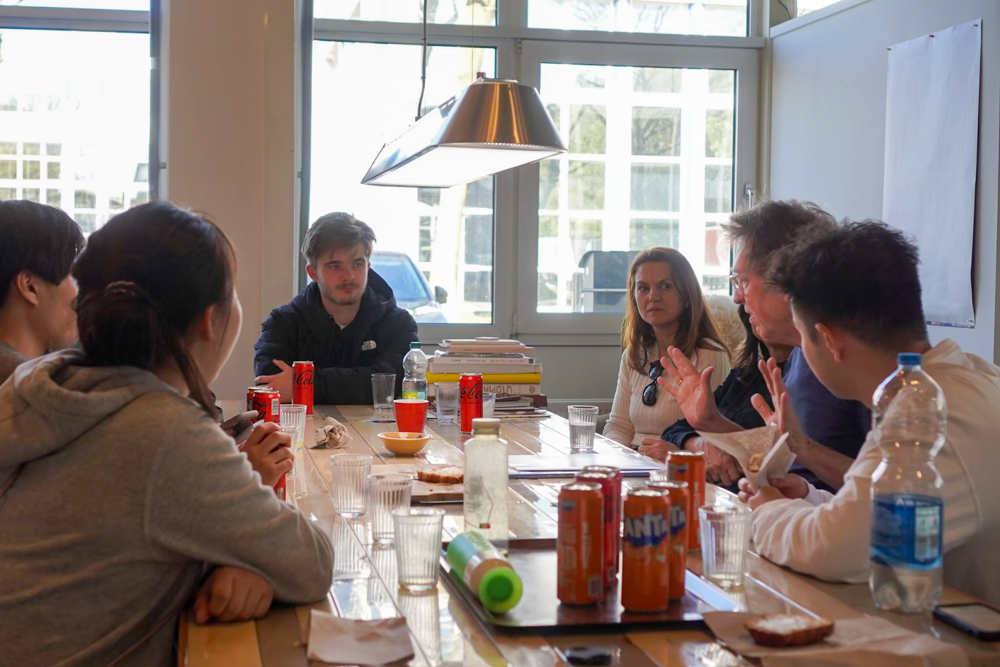
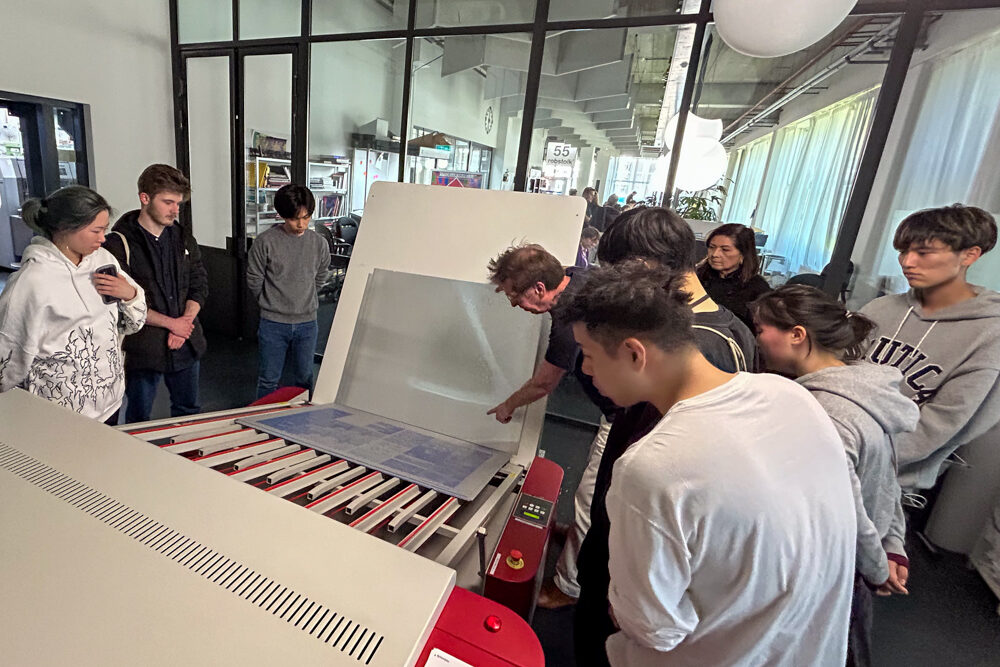
担当者memo
Editor’s note
充実した濃い5日間を過ごしたようですね。2024UIF オランダツアー記事はまだまだ続きます。後編もどうぞお楽しみに!
「上智のいまを発見」では学生の活躍、耳寄り情報、先生によるコラム、先輩紹介など、大学の中と外でおきているあれこれを特集しています。取り上げてほしい人や話題など、みなさんからの情報も募集中。情報提供は findsophia-co(at)sophia.ac.jpまで。記事形式、ビデオ、写真、アイディアなど形式は問いません。どうぞ自由な発想でお送りください。*残念ながらすべての応募情報にお答えすることはできません。採用させていただく場合のみご連絡をいたします。
What a rich five days! Check out the second half of the UIF Dutch Tour 2024 in a separate article as well!
In the Find Sophia Now, we feature the activities of students, useful tips for student life, columns by our professors, introductions of our seniors, and other topics inside and outside the university. We are also looking for information about people and topics that you would like us to cover. Please send us your suggestion to findsophia-co(at)sophia.ac.jp. Any format is acceptable, including articles, videos, photos, and ideas so feel free to provide us your ideas. (We cannot respond to all submissions and we will only contact you if we decide to select your idea.)
